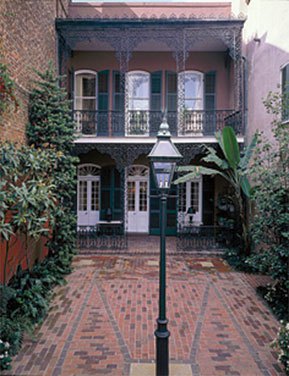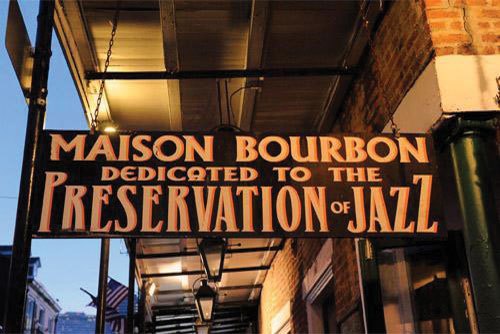My partner, Rick Ellis, and I have been coming to New Orleans for over 20 years. At first, Rick, who is a food stylist and culinary historian, was attracted to the wonderful food and its rich history, and as an antiquarian, I was also drawn to the history and architecture.
We found the parlor floor of an 1836 Creole townhouse in the heart of the French Quarter, and we try—if things are not too hectic with work—to get down there every six weeks or so. There’s still so much to discover, friends to connect with, and never enough time to make it all happen. But in an ideal world here is how we might spend a day of leisure in our adopted city.
Coffee & Breakfast
This perfect day (or any day for that matter) has to start with caffeine. When we don’t feel like battling the hordes at Café du Monde, we’ll start at a coffee bar down the street called Spitfire Coffee (627 St. Peter St.). They’re very serious about coffee—no pastries, just coffee. I go there to catch up with people. It’s housed in what I think is a former t-shirt shop, and I am glad that parts of the French Quarter are turning back into true neighborhood hangouts versus tourist traps.
Farmers Market
If it’s a Saturday, we’ll take a walk through the Crescent City Farmers Market (700 Magazine St. at the corner of Girod), where everything sold is local. We always buy tamales and fresh flowers. Even though it’s still early in the day, it gets us talking about the major topic of conversation for everyone in New Orleans…what or where are we going to eat next? The market usually convinces Rick to cook something special for dinner. I’ll beg for his gumbo, or will we be going out?

The Williams Residence
House Museums
Later in the morning I stop in at one of New Orleans’ house museums. There are three really interesting ones that are often overlooked. Occasionally their curators even like to ask my advice about projects they’re working on, and I’m always game to offer an opinion. I appreciate each house’s magnificent qualities and the people who work there.
- Gallier House (1132 Royal St.), a Victorian-era house that is full of bric-a-brac, has been restored with great authenticity.
- The Williams Residence, an Italianate house built in 1889, oozes with Southern/Hollywood glamour of the mid-20th century (718 Toulouse St.).
- The Hermann-Grima House (820 Saint Louis St.) is a big Greek Revival house that still has its original kitchen where they hold cooking classes. A little fun fact: The house backs up to a strip club (complete with a pole in the back courtyard), and the people who run the house have negotiated with the establishment so that the strippers never climb higher than their “party” wall. This prevents refined visitors from receiving a modern-day “flash of surprise.” Such treaties show the importance of being a good neighbor—always a plus in New Orleans, with the many currents that give character to this city.
Lunch
We’ll break for lunch and have a muffaletta in the charming courtyard at Café Amelie (912 Royal Street), established by our good friends Susan Hoffman, Danny Akers, and chef Jerry Mixon. The setting, food, and their personalities exemplify what has brought people to New Orleans for centuries.
Paddleboat Cruise
If it’s a beautiful day (and my perfect day certainly will be sunny), we’ll walk down to the river. We recommend to visiting friends that they take a paddleboat cruise on the Creole Queen (365 Canal St.). It provides the most amazing views of America’s most important river. Some of them resemble old-time postcards from the 19th century, and really demonstrate the heart of New Orleans. When we don’t feel like taking a ride, we just watch the barges go by…some of my family grows corn in Iowa, and I like to imagine that it’s their harvest I’m watching traveling out to sea.
Gardens

Rock Garden at Longue Vue Gardens | Photo Courtesy of Longue Vue Gardens. | Photo by Ryan Lips
Next, New Orleans is known for beautiful gardens, and we’ll stroll through Armstrong Park (835 N. Rampart St.) to check in on what’s blooming, particularly the antique roses curated by our friend, Leo Watermeier. It is the South’s largest collection of old roses in a climate where they bloom all year long.
We’ll also visit Longue Vue Gardens (7 Bamboo Rd.), designed by the renowned garden designer Ellen Biddle Shipman in the ‘30s. We never miss their fine native iris collection in bloom. The house did well in Katrina, but the gardens were severely damaged. Happily, there has been an extensive restoration, and the addition of special gardens for children that are full of charm. Longue Vue’s success is an outstanding reminder to me of how resilient the city is, and how it has bettered itself in the aftermath of tragedy.

The Napoleon House
Shopping & Antiques
Any perfect day must also include buying something beautiful, and the city offers plenty of options, particularly for an antiques lover like me. I’ll duck into M.S. Rau Antiques (630 Royal St.) to eyeball the showstopping French furniture that is always bold and highly polished. Rau’s exemplifies the famous antiques stores here, and there’s a particular genius in what the owner, Bill Rau, sells—it’s always an education. Then down to Nadine Blake (1036 Royal St.), for its interesting mix of everything from handmade cards to antique textiles. Recently there was a special display of small porcelain vases, very fine, but modestly priced. Nadine’s mother sometimes sits shop, and both women are great New Orleans personalities who tell the best stories. And we all compete to make an addition to Nadine’s pin-up board of ephemera. Ann Koerner Antiques (4021 Magazine St.), has strong pieces with beautiful surfaces that are quiet and understated, and all selected with Ann’s artistic and impeccable eye.

Meauxbar |Photo by Rush Jagoe
Cocktails
All this walking (and shopping) will surely make us thirsty, so it’s time for a cocktail—though when isn’t it time for a cocktail in New Orleans? It’s fun to go to one of the classic places, so we’ll pop into the old-time Napoleon House (500 Chartres St.) for a Sazerac, a rejuvenating combination of rye whiskey, Herbsaint, and Peychaud bitters. On the outside of Napoleon house is a vintage plaque that reads “Napoleon Bonaparte Refuge Offered,” from the time when the mayor of New Orleans offered exile to the banished leader. And for a modern take on this signature beverage there is the Sazerac Bar at the Roosevelt Hotel (123 Baronne St.). Even if you don’t drink, both spaces will amuse you.
Dinner
Then it’s on to dinner, where there is a never-ending parade of choices. Although I think some of the best meals emanate from our own kitchen, tonight we’re choosing between my favorite restaurant in New Orleans, the pork-centric Cochon (930 Tchoupitoulas St.), where I’ll order the fried chicken livers with pepper jelly, or Meauxbar (942 N. Rampart St.). It’s our perfect bistro, both cosmopolitan and neighborhoody, low-key but not too informal, and it’s as much about the room and the people as the menu. The proprietors, James Conte and Matthew Guidry, certainly know how to make us denizens of the French Quarter happy.
Jazz
We’ll end the day by engaging in one last renowned New Orleans pastime: listening to some jazz. Preservation Hall (726 St. Peter St.) is a can’t-miss standard, but tonight we go Maison Bourbon (641 Bourbon St.), one of the last old-fashioned jazz clubs in the city. And if we are feeling lazy, we’ll just listen to the music from the privacy of our own home, as we can often hear them playing—another charming aspect of living in the Quarter.

Now it’s time to call it a night (or is it early morning?), and go to sleep behind our 19th-century shutters, perchance to dream, of actually finding a time to make my “perfect day” happen. Laissez les bons temps rouler!
Thomas Jayne blogs regularly at Decoration Ancient and Modern. He has written two books: The Finest Rooms in America and American Decoration: A Sense of Place,both published by The Monacelli Press.
Produced by Karen Carroll




